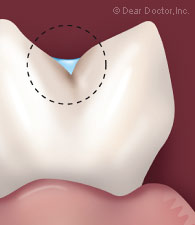Tooth Decay — The World's Oldest & Most Widespread Disease
A Look at the Process of Dental Caries — And How to Prevent It
(Continued)
Strategies for Prevention
You can see now that prevention doesn't simply mean brush and floss and don't eat sugar. It is a complicated topic with many implications. In fact, your dental office may offer some additional steps to measure your caries risk (salivary and bacterial analysis) and then recommend some products that specifically manage your risk level (sealants, antibacterial agents, topical fluoride, calcium and phosphate supplements, pH neutralizers, special toothpaste and rinses, and xylitol gum). These strategies are based on tipping the balance toward health by maximizing the protective side and minimizing or eliminating the pathogenic side. Prevention must be strategic, since it affects planning on an individual and community level.
Tipping the Balance — the Right Recipe
Simply put, for dental caries (tooth decay) to occur you need the right (or rather wrong) recipe:
- Susceptible teeth (not all teeth get caries),
- Acid producing bacteria,
- Sugars or carbohydrates — the “perfect” food for the acid producing bacteria
Prevention aims to shift the balance in favor of promoting health in three main areas:
 |
| Figure 1: An illustration of a sealant protecting the groove of a tooth from tooth decay. |
- Protecting the teeth from caries — this is best accomplished by applying fluoride topically to the crystalline structure just after the teeth erupt into the mouth. The tooth surfaces are dynamic and will allow incorporation of fluoride ions into the surface structure. Many studies show that low doses of fluoride are safe and effective against decay. Sealants are very successful and are a companion treatment to fluoride because they seal the places where decay occurs in the tiny hidden pits and fissures [Figure 1]. Clinical studies using sealants show 99% cavity-free results during six years of clinical testing on more than 1,100 teeth studied.
- Identifying and reducing acid-producing bacteria — these bacteria can be identified by a simple test administered by your dentist. If these bacteria are identified, they can be modified to reduce tooth decay by the use of tooth protective products. We can further modify these harmful bacterial concentrations with the use of antibacterial mouthrinses (such as chlorhexidine) and pH neutralizing agents. It is important to note, infants are not born with the specific decay-causing bacteria but that these bacteria are actually transmitted through saliva from mothers, caregivers, or family members to young children — another reason to practice prevention.
- Controlling diet — sugars and other carbohydrates can be fermented by bacteria to produce acids. It's important to reduce refined sugars from the diet or restrict intake to mealtimes. Natural sugars (in raw fruits and vegetables) are better than the free (added) sugars found in juices, sodas, candy and the like. Total sugar intake should be less than fifty grams, about ten teaspoons, per day. Snacking between meals is dangerous because it promotes an acid environment that would take up to thirty minutes for healthy saliva to neutralize. Healthy non-sugary or non-carbohydrate snacks are therefore better, like carrots, vegetables and fresh fruits. Xylitol is an example of an “alcohol sugar” used in some chewing gums and dental products that actually reduces decay-producing bacteria, and is proving useful in decay preventing strategies. One study showed that pregnant mothers who chewed xylitol gum before giving birth reduced the transmission of these strains of bacteria to the child, thus reducing the likelihood of decay.
Today's Treatments Can Reduce and Eliminate Tooth Decay
We understand that tooth decay, or dental caries as it is known, is a disease process, and we know the causes. As we'll see in future articles, methods of prevention, early detection, protection and treatment have continued to improve. Dentists are using a more preventive strategy — profiling individuals' degree of risk and implementing preventive strategies to keep their teeth decay-free for life.

